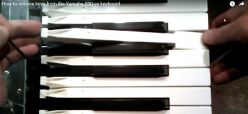There are times when you need to remove the keys from your keyboard like when the felts go bad or the contacts break down or your keys get damaged on the gig. Almost all keyboards have a trick or two that makes removing keys easy.
The Yamaha S90 ES keyboard is a great set of keys and if you need to remove the keys it’s good to know how to do it right so you don’t break anything in the process.
What happened to me is that I occasionally carried my S90 ES around without a case and one night someone who had offered to hold the door open for me suddenly let go when their cell phone rang. The lower keys were smashed and pieces of the keys got in under the keybed, causing problems with the action.
Hopefully this will help you remove your keys when something happens.
Step One: Open Keyboard Lid
Don’t do this on your keyboard stand because once you open the lid the thing can fall off backwards which would put damaging strain on wires and connectors. Instead, put the keyboard on some books on a table so that there is room to open the lid but not room for the lid to fall all the way back.
First remove the 18 black nipple style screws on the bottom of the keyboard. Once you’ve done that, the lid can be opened. Be aware of a couple of protrusions inside the lid by the right and left front corners where it fits into slots attached to the keyboard body. Sometimes these need to be worked loose.
Don’t forget about these slots when you are trying to get the lid back down. If it’s not fitted into the slots right the lid will be loose with about a quarter inch of wiggle room
Step Two: Remove Front Bar
After the lid is open you’ll need to take off the front bar that covers up the space under the keys.
There are ten wood screws on the bottom along the front and two shorter metal screws on the front at the far left and right side. Careful, when you remove all these screws the bar will fall off.
Step Three: Remove Keys
First, find a thin piece of metal or plastic such as a fingernail file or spark plug gap tester. I used a street cleaner brush piece, they work perfectly.
Each white key has a little arrow on the right or left side that is about 1.5 inches from the back of the key. This arrow designates where to insert the thin piece of metal or plastic you are using. Push it down just a bit and slightly pull back on the key until it pops loose.
When you’ve pressed hard enough, the thin piece of plastic protruding from the bottom of the key will move enough to release the key., the key will releaseAll you are doing is slightly moving a thin piece of plastic connected to the key just enough to release it. You do not have to force this, the key will pop loose as soon as you’ve pushed the tool down enough.
Step Four: Putting Keys Back On
When you put the keys back on, make sure they are hooked into the white plastic hammer slot at the front of the key. This is important because if you don’t do this, the key won’t work or be at the same level as the other keys.





